Millennium Seed Bank Project
- 指点迷津
- 2024-11-30
- 5
In this unlikely place, researchers are putting the seeds from flowering plants and trees in a sleeplike state called suspended animation3. Many years from now, other workers will rouse the slumbering4 plant embryos5 and plant them where they're most needed.
These seeds are like the legendary6 Rip van Winkle, who fell asleep under a tree and woke up 20 years later. The small farm, called the Greenbelt Native Plant Center, is part of a global effort to save threatened plants and trees.
| Around the world, workers are collecting seeds from native plants for long-term storage. The worker above is gathering salt marsh grasses on New York's Staten Island. |
| Greenbelt Native Plant Center |
Around the world, native plants are being crowded out by invasive newcomers, which can hitch9 rides on boats, planes, and trains. Unaware10 of the consequences, people sometimes even plant invasive species because they seem useful or pretty at first.
Adding insult to injury, native plants have less room to grow now as a result of the growth and spread of cities. And global warming is making some places hotter, drier, or otherwise different from what native plants are used to.
Bittersweet peril11
American bittersweet is a good example of a plant in peril and one whose seeds should be stored, says Steven Clemants, vice12 president for science at the Brooklyn Botanic Garden in New York City. The plant, a climbing vine with orange berries, is native to the eastern United States. But an evil twin called Oriental bittersweet is elbowing it out of the way.
People brought Oriental bittersweet to the United States in the 1860s because gardeners loved its fall display of yellow leaves and orange berries. Too late, they realized that the imported beauty was really a beast. The thorn-studded invader13 can wrap itself around trees and slowly kill them. Now, the transplant is threatening to replace its harmless native counterpart.
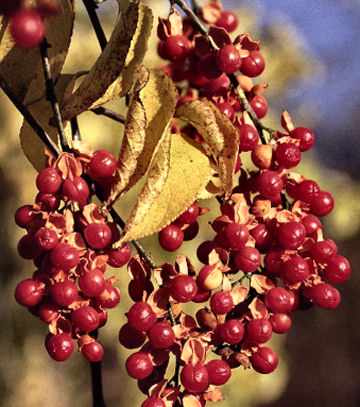 |
| In New York City, among other places, an invasive species called Oriental bittersweet (below) is rapidly replacing the native American bittersweet (above). The two plants may look alike, but the invader is far more destructive. |
| Millennium14 Seed Bank Project |
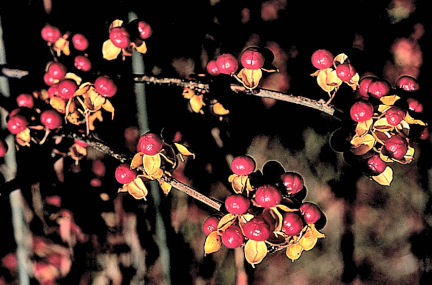 |
|
|
| Millennium Seed Bank Project |
Experts used to think that it was impossible to protect big-city plants such as American bittersweet because growth space is limited in urban environments. Crowding increases competition between natives and invaders15, and the aggressive aliens often win the battle.
But botanists16 are now teaming up and fighting back. The Brooklyn Botanic Garden is trying to identify all of the estimated 1,000 plant species that grow within 50 miles of New York City. So far, workers at the Greenbelt Native Plant Center have gathered seeds from about 300 of those plants, says Edward Toth, the center's director.
The seeds are being kept in storage compartments18 at the Greenbelt Center. Some are also being held as part of an international collection in Europe.
When planted in the future, these seeds could help restore damaged parklands and forests. Revived plants could also protect reservoirs of drinking water by filtering out pollution.
Sleeping seeds
The New York project is getting storage tips from the Millennium Seed Bank, a project in the United Kingdom run by the Kew Royal Botanic Gardens. Michael Way, a coordinator19 with the British project, says that the most important step is to collect seeds at exactly the right time— when they are just about ready to fall from the plant.
| At the Greenbelt Native Plant Center, some seed collections are air-dried before entering special chambers to be cooled, dried, and stored. |
| Greenbelt Native Plant Center |
Workers then store the seeds at a constant temperature of 59º Fahrenheit21 (15º Celsius) while slowly drying them in specially22 designed chambers. The temperature and humidity in the chambers is similar to that on a fall night in the southern Arizona desert.
After the seeds dry, they can enter a state of suspended animation when stored at a frosty –4ºF (–20ºC). That's like January in northern Minnesota.
How long can chilled seeds survive? "There's a huge variation between species," Way said.
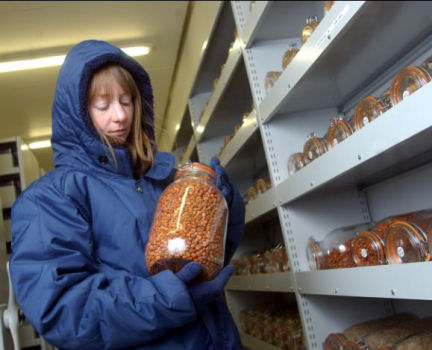 |
| A worker checks on containers of seeds at a storage facility run by the Millennium Seed Bank Project in England. She is bundled up because the seeds are stored at a frosty –4ºF (–20ºC). |
| Millennium Seed Bank Project |
Some seeds last only 30 years, while others can "sleep" for up to 10,000 years! If stored properly, Way says, seeds from 90 percent of the plants that grow in the New York area should last 200 years or more.
Sprouting23 toward the future
The Millennium Seed Bank, Brooklyn Botanic Garden and Greenbelt Native Plant Center are among many contributors to a national project called Seeds of Success, run by the U.S. government.
The government manages about 600 million acres of land—nearly one-fourth the area of the entire United States, including Hawaii and Alaska. Invasive plants are taking over much of that land, says Peggy Olwell, a botanist17 with the government's Bureau of Land Management. To make things worse, forest fires in the western United States are destroying more vegetation than they used to.
Seeds of Success workers have been collecting seeds in the prairies, deserts, and mountains of the West since 2001. Now, they're doing the same thing on the East Coast. Organizations in Chicago, Texas, and elsewhere are pitching in with seeds from their areas.
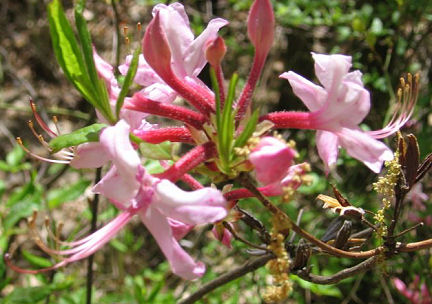 |
| This pink-colored Pinxterbloom Azalea bush on New York's Staten Island is one of the plants whose seeds will be collected by the Millennium Seed Bank Project. |
| Millennium Seed Bank Project |
Collecting seeds for storage can be challenging. Sometimes, human seed collectors have to compete with insects and other animals that like to eat seeds and the fruits that contain them.
Some plants are very delicate, and the workers have to sneak24 up on them. Consider, for example, the narrowleaf four o'clock. Each of this prairie plant's pink flowers produces a single seed that can fall off with the slightest breeze—or sneeze.
The hard work is paying off. So far, more than three dozen collection teams assisting Seeds of Success have helped stash2 away seeds from some 3,000 flowering plant species. In all, about 18,000 to 20,000 flowering species grow in North America north of the Mexican border.
Some of the seeds will be frozen and put into long-term storage at U.S. Department of Agriculture facilities in Colorado and Washington State. Other seeds will be kept cold until they can be given to growers, researchers and agencies that request them.
The Department of Agriculture has a lot of experience banking25 seeds. The government agency manages more than 480,000 collections of seeds in 21 separate facilities. Altogether, these banked seeds represent nearly 12,500 different species. Most of them have the potential to become crops.
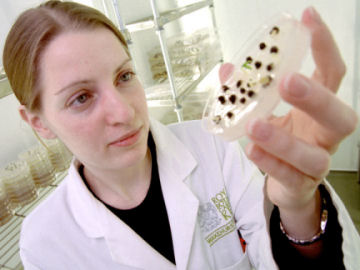 |
| A scientist with the Millennium Seed Bank studies the types of growing conditions that revived plant seeds prefer. |
| Millennium Seed Bank Project |
The Millennium Seed Bank is also huge. Earlier this year, the number of seeds in this international collection reached 1 billion. The billionth seed came from an African bamboo plant that produces seeds only once every 7 years.
The international project aims to store seeds from one-tenth of the world's flowering plants, or about 30,000 species, by 2010. After that, there will still be enough room to stockpile seeds from half of the world's flowering plant species.
With the right care, the leafy Rip van Winkles should be around for a very long time.
本文由明日于2024-11-30发表在生活百科-红苹果乐园,如有疑问,请联系我们。
文章摘自:http://hpgly.com/post/33469.html










![[流言板]雷尔森传中,穆科科近距离射门打飞](/zb_users/upload/2024/12/3111596453046865195.gif)
发表评论